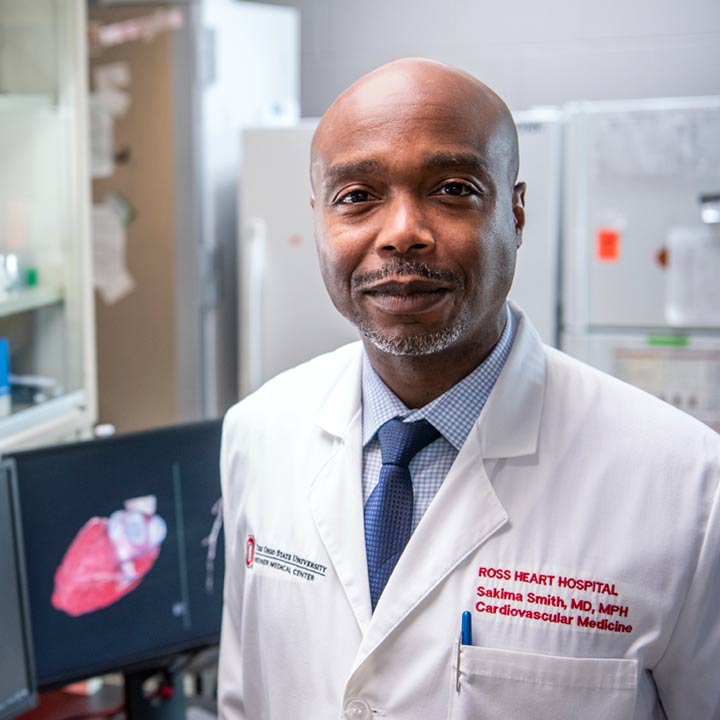
Building a research powerhouse in microbial pathogenesis and immunology
 Within the past decade, Sakima Smith, MD, MPH, FAHA, associate professor in the Division of Cardiovascular Medicine at The Ohio State University College of Medicine, and his colleagues noticed a puzzling trend among their patients.
Within the past decade, Sakima Smith, MD, MPH, FAHA, associate professor in the Division of Cardiovascular Medicine at The Ohio State University College of Medicine, and his colleagues noticed a puzzling trend among their patients.
A small percentage of those who had previously been treated for cancers were developing heart conditions. Because life-saving cancer treatments meant survivors were living longer, the link between treatment and adverse impacts to the heart was a new discovery.
Researchers around the globe began exploring a new field called cardio-oncology, with the goal of understanding the connections between cancer treatments and the heart. Dr. Smith, who holds the Bob Frick Research Chair in Heart Failure and Arrhythmia at Ohio State, set his sights on developing cardioprotective mechanisms and ways to detect early signs of heart problems in patients undergoing cancer treatment.
For nearly 10 years, Dr. Smith has split his time between the research lab and the bedside of patients undergoing treatment at The Ohio State University Comprehensive Cancer Center – Arthur G. James Cancer Hospital and Richard J. Solove Research Institute (OSUCCC – James). This continual process allows him to take what he learns in the lab and translate it into better treatments for patients. According to Dr. Smith, this work is especially vital to patients because if negative impacts to a patient’s heart are detected early, treatment can be altered or adjusted.
“The goal isn’t to take patients off these life-saving therapies,” Dr. Smith says. “The goal is to support and protect the heart while continuing to effectively treat their cancer.”
A five-year, $2 million grant from the National Heart, Lung and Blood Institute at the National Institutes of Health will allow Dr. Smith and his team to study the rise in the incidence of cancer treatment-related cardiotoxicity.
The grant, “Defining Novel Cardiovascular Mechanisms For TKI-Induced Excitability,” will focus on cancer-treatment drugs called tyrosine kinase inhibitors (TKIs) to determine their role in modulating cardiomyocyte (heart muscle cell) excitability and to define therapeutic strategies for mitigating TKI-induced cardiac dysfunction. A form of targeted therapy for some cancers, TKIs block the action of tyrosine kinase enzymes in cancer cells to help prevent them from growing and spreading.
“TKIs can be life-saving therapies for many patients,” Dr. Smith says, “but unfortunately, adverse cardiovascular side effects are common and can lead to the discontinuation of this life-saving therapy. This grant study is motivated by our hypothesis that TKI-induced arrhythmia acts in part through activation of a key cardiac protein in heart cells and increased late sodium current in cardiac cells leading to arrhythmias.”
The researchers’ data supports the premise that TKIs can modify and inhibit cardiac voltage-gated Na+ sodium channel Nav1.5, a cardiac isoform that plays a key role in heart excitability and conduction. Also, TKIs have been shown to increase reactive oxygen species (ROS) in cardiomyocytes. In turn, ROS “is known to activate the multifunctional Ca2+/calmodulin-dependent kinase II (CaMKII), which resides at the hub of a pro-arrhythmia signaling hub in cardiac myocytes.”
“Study results will inform clinical decision-making regarding drug-induced arrhythmias, inform mechanistic approaches to prevent Ca2+ (calcium ions) overload, and define an innovative approach using drugs readily available on the market as cardioprotective agents for patients during TKI therapy,” Dr. Smith says.